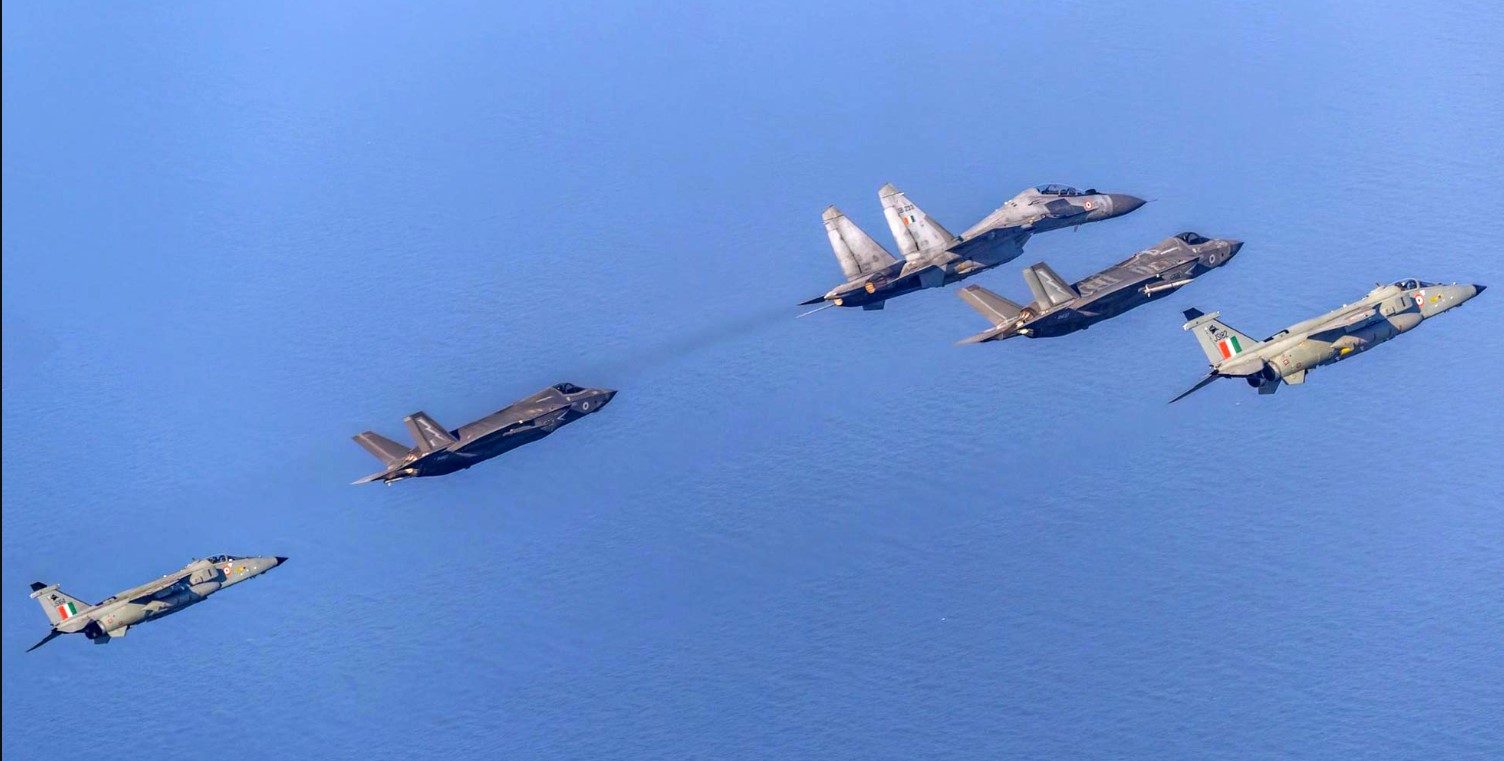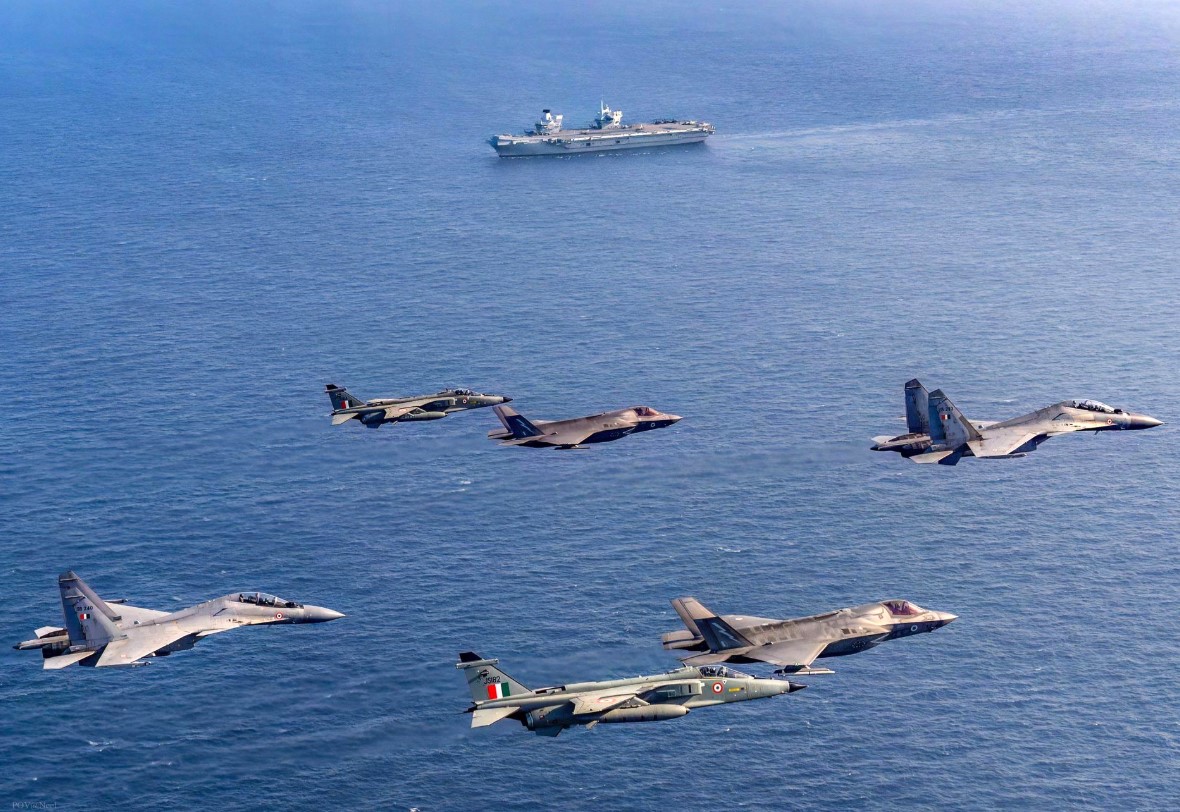The instructions to Indian fighter pilots were crystal clear – “Target the HMS Prince of Wales” in the Arabian Sea. Within seconds, a dozen Indian fighter jets, including eight Su-30MKIs, an Indian Il-78 aircraft, and four Jaguars, were airborne to penetrate the defensive shield of HMS Prince of Wales and conduct simulated airstrikes on the UK’s flagship carrier.
They were challenged by half a dozen British stealth F-35Bs on board the HMS Prince of Wales.
This was the first simulated aerial battle between the Indian Su-30 MKIs, the mainstay of the Indian Air Force, and the British F-35Bs, the primary aircraft on the two British carriers, HMS Prince of Wales and HMS Queen Elizabeth.
The simulated air battle took place as part of Konkan 2025, focusing on defending the aircraft carrier HMS Prince of Wales. Indian Su-30 MKIs and Jaguars, supported by AEW&C aircraft, practiced attacks on the British aircraft carrier and Carrier Strike Group 25 (CSG25).
The RAF listed 22 jets participating in the scenario, including six F-35Bs from the 617 Squadron embarked on the HMS Prince of Wales.
According to the RAF, the services practiced “four dogfights” and “three mission types.”
The simulated air drill—the first of its kind—helped the Royal Navy and the IAF test each other’s tactics, skills, weapons systems, sensors, and interoperability.

Furthermore, while the IAF trained against a stealth fighter jet in close air combat, the Royal Navy practiced against the Su-30 ‘Flankers.’
This assumes significance in view of the rising tensions with Russia.
Notably, in addition to Russia, the Su-30 ‘Flankers’ are also operated by China’s PLA Air Force (PLAAF). The PLAAF also operates a locally produced variant of the Su-30, the J-16.
Exercise #BersamaLima has wrapped up! 🤝
Over two weeks, the UK joined Malaysia, Singapore, Australia and New Zealand for training across sea, air and land.
The @COMUKCSG is now heading to India for further defence engagement.#CSG25 pic.twitter.com/8Qk2T7sL04
— Royal Navy (@RoyalNavy) October 6, 2025
In a press release, the Royal Navy said: “Indian pilots jousted with British top guns high over the Arabian Sea as the UK Carrier Strike Group ended its visit with a major workout for Anglo-Indian air power.”
“Half a dozen F-35Bs acted as the carrier’s shield, while a dozen Indian fast jets – eight Su30 ‘Flankers’ and four Jaguars, aided by an Il-78 aircraft – tried to penetrate the defensive screen to conduct simulated strikes at the flagship as well as her escorts.
“For the air power of both nations, the mock dogfights allowed personnel to test individual skills, weapons systems and sensors, plus tactics in particular against aircraft they do not normally encounter,” it said.
The Royal Air Force (RAF) said it was the “first UK carrier clash with Flankers testing fusion, agility and tactics.”
While the results of the maneuvers remain classified, they are not hard to guess.
Being a fifth-generation stealth fighter, the F-35B has a clear advantage in Beyond Visual Range (BVR) combat. However, in dogfights, the Su-30 MKI can be equally lethal.
Due to its twin engines, the Su-30 MKI has better thrust and speed. Its top speed is Mach 2.0, whereas the F-35B’s is Mach 1.6.
Similarly, the Su-30 can produce a thrust of 55,000 lb vs the F-35B’s 41,000 lbf. Furthermore, the Russian Su-30 is optimized for super maneuverability.
Nearly three squadrons of the Indian Su-30 MKIs, a highly customized version of the Russian Su-30, are also integrated with BrahMos, a joint Indo-Russian supersonic cruise missile.
The Su-30 MKIs are the IAF’s mainstay. India has 260 Su-30 MKIs and ordered 12 more in December 2024.
The IAF’s Jaguar is another “deep penetration strike aircraft.” Notably, its shallow penetration makes it as stealthy as the F-35B and F-22 Raptors at certain angles.
The IAF Jaguars have been upgraded to DARIN-III standards, which feature AESA radar, new-generation AAMs (air-to-air missiles), ASMs (Anti-ship missiles), sensor-fused armament, and extended-range LGBs.
The DARIN III includes an open-system architecture mission computer, multi-functional displays, an engine and flight instrument system, a new fire control radar, a geodetic height correction system, and an inertial navigation system with multiple satellite navigation.

The DARIN III Jaguars have also been equipped with the Israeli EL/M-2052, which enhances their resistance to electronic warfare jamming. By having multiple transmit-receive modules (TRMs), each transmitting on a different radio frequency, the EL/M-2052 also reduces the probability of enemy radar warning receivers.
In other words, the Jaguar DARIN III is more difficult to detect and jam.
DARIN-III avionics support the integration of advanced air-to-air missiles such as ASRAAM and smart air-to-surface munitions such as RAMPAGE, Maverick, and Harpoon missiles; Paveway precision-guided munitions; the Joint Standoff Weapon; and the DRDO-developed SAAW (Smart Anti-Airfield Weapon).
According to the Royal Navy (RN) press release, the drills involved four dogfights, and the IAF must have impressed the RN with these mock drills.
The drills also involved three special “mission types.” However, no further information was provided about these ‘special missions’.
Lieutenant Daniel Randel, a staff officer on board HMS Prince of Wales, said: “Konkan has been a great opportunity to see how the Indian armed forces work. Working with both their navy and air force has been a unique experience in my career so far.”
Notably, this was the Royal Navy’s second mock drill this year against the Su-30s. Earlier in October, the RN’s F-35Bs flew with Su-30s of the Royal Malaysian Air Force during Exercise Bersama Lima 2025, which concluded on October 6.
Bersama Lima also saw the participation of Australia, New Zealand, and Singapore.
Interestingly, just days after these mock drills, India and the UK signed an agreement under which the IAF instructors will train the Royal Air Force cadets.
Starting next year, Indian “Top Guns” will teach British cadets how to fly Hawk T2 fast jets at RAF Valley in North Wales. The advanced jet trainer Hawk T2 provides the ideal lead-in trainer for pilots transitioning to frontline aircraft such as the Eurofighter Typhoon and the F-35B.
Konkan 2025 was part of Operation Highmast, during which the Royal Navy’s Carrier Strike Group (CSG), led by the aircraft carrier HMS Prince of Wales, was on an eight-month deployment across the Indo-Pacific region, which included a journey through the Mediterranean and the Middle East.
The mission’s objectives were to conduct exercises with allies, demonstrate collective resolve, showcase British trade and industry, and confirm the operational readiness of the UK’s carrier strike group.
“Operation Highmast is a multinational deployment led by the UK Carrier Strike Group providing an opportunity for the UK’s Armed Forces to conduct a major global deployment and a chance to exercise complex operations alongside partners and allies in the region, with 12 other nations supporting the deployment with ships or personnel,” said a Royal Navy press statement.
The HMS Prince of Wales hosts 24 F-35Bs, both from the Royal Navy and the Royal Air Force, assigned to the 809 NAS (Naval Air Squadron) and the 617 Squadron “Dambusters,” respectively.
Notably, an F-35B from the HMS Prince of Wales was stranded in the Indian state of Kerala for over five weeks in June this year, after it had to make an emergency landing due to a technical snag.
- Sumit Ahlawat has over a decade of experience in news media. He has worked with Press Trust of India, Times Now, Zee News, Economic Times, and Microsoft News. He holds a Master’s Degree in International Media and Modern History from the University of Sheffield, UK.
- VIEWS PERSONAL OF THE AUTHOR.
- He can be reached at ahlawat.sumit85 (at) gmail.com




